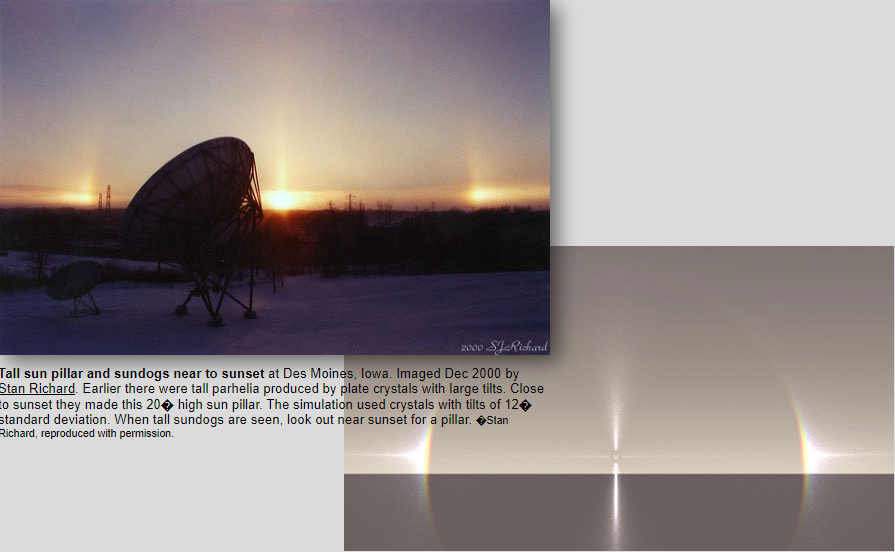Tall plate crystal sun pillar
Tall Plate Crystal Sun Pillar: A Spectacular Atmospheric Phenomenon
Have you ever witnessed a mesmerizing display of light in the sky during sunset? One such captivating phenomenon is the tall plate crystal sun pillar. This optical marvel occurs when sunlight interacts with ice crystals in the atmosphere, creating a vertical column of light that extends above the setting sun. In this article, we will delve into the intricacies of this stunning atmospheric optics event, exploring its formation, characteristics, and where and when to observe it.
How Does a Tall Plate Crystal Sun Pillar Form?
A sun pillar is formed when sunlight interacts with horizontally-oriented ice crystals suspended in the air. These crystals can take the form of thin, plate-like structures that align themselves parallel to the ground. As the sun begins to set, its rays pass through these ice crystals, causing them to act as tiny prisms. The light is then refracted and reflected within the crystals, creating a vertical beam of light that extends above the sun's position on the horizon.
Characteristics of a Tall Plate Crystal Sun Pillar
The tall plate crystal sun pillar is characterized by its impressive height and vertical alignment. Unlike other types of sun pillars, which may appear shorter or more slanted, this particular phenomenon can reach heights of up to 20 degrees above the horizon. The height of the pillar is dependent on various factors, including the size and tilt of the ice crystals present in the atmosphere.
Factors Influencing the Formation of a Tall Plate Crystal Sun Pillar
Several factors contribute to the formation of a tall plate crystal sun pillar. These include:
- Ice Crystal Shape: The presence of horizontally-oriented plate-like ice crystals is essential for the formation of this phenomenon.
- Crystal Tilt: The tilt angle of the ice crystals also plays a crucial role. In the case of tall pillars, crystals with larger tilts are often responsible for the vertical alignment of the light beam.
- Sun Angle: The position of the sun in relation to the observer is another determining factor. A low sun angle, such as during sunset or sunrise, provides the ideal conditions for the formation of a tall plate crystal sun pillar.
Observing a Tall Plate Crystal Sun Pillar
If you're keen on witnessing this awe-inspiring atmospheric display, keep the following tips in mind:
- Time of Day: The best time to observe a tall plate crystal sun pillar is during sunset or shortly before sunset. As the sun descends on the horizon, be on the lookout for the appearance of this stunning phenomenon.
- Weather Conditions: Clear skies are optimal for observing a sun pillar. Cloud cover or haze may obscure the view and diminish the visibility of this natural spectacle.
- Location: While tall plate crystal sun pillars can occur in various locations, they are more commonly observed in colder regions where ice crystals are abundant in the atmosphere.
Other Associated Atmospheric Optics Phenomena
During the same atmospheric conditions that favor the formation of a tall plate crystal sun pillar, you may also have the opportunity to witness other related phenomena. These include:
- Sundogs: Sundogs, also known as parhelia, are bright spots of light that appear on either side of the sun. They are caused by the refraction and reflection of sunlight by ice crystals in the atmosphere.
- Halos: Atmospheric halos are luminous rings or arcs that encircle the sun or moon. They are created by the refraction and dispersion of light through ice crystals, similar to what occurs in a sun pillar.
Capturing the Beauty of a Tall Plate Crystal Sun Pillar
If you're an avid photographer, capturing the beauty of a tall plate crystal sun pillar can be a rewarding experience. To photograph this phenomenon effectively, consider the following:
- Camera Settings: Use a low ISO setting and a small aperture (high f-stop number) to ensure a sharp image with a large depth of field.
- Composition: Frame the sun pillar within your shot, making sure to include any surrounding landscape or interesting elements to enhance the overall composition.
- Timing: Experiment with different exposures and timings to capture the sun pillar at its most vibrant and captivating moments.
Conclusion
The tall plate crystal sun pillar is a remarkable atmospheric optics phenomenon that mesmerizes observers with its vertical beam of light extending above the setting sun. Understanding its formation, characteristics, and ideal observing conditions allows us to appreciate the intricacies of nature's light show. So, keep an eye on the sky during sunset, and you may be fortunate enough to witness this enchanting display firsthand.

Tall sun pillar and sundogs near to sunset at Des Moines, Iowa. Imaged Dec 2000 by Stan Richard. Earlier there were tall parhelia produced by plate crystals with large tilts. Close to sunset they made this 20� high sun pillar. The simulation used crystals with tilts of 12� standard deviation. When tall sundogs are seen, look out near sunset for a pillar. �Stan Richard, reproduced with permission.
Note: this article has been automatically converted from the old site and may not appear as intended. You can find the original article here.
Reference Atmospheric Optics
If you use any of the definitions, information, or data presented on Atmospheric Optics, please copy the link or reference below to properly credit us as the reference source. Thank you!
-
<a href="https://atoptics.co.uk/blog/tall-plate-crystal-sun-pillar/">Tall plate crystal sun pillar</a>
-
"Tall plate crystal sun pillar". Atmospheric Optics. Accessed on November 22, 2024. https://atoptics.co.uk/blog/tall-plate-crystal-sun-pillar/.
-
"Tall plate crystal sun pillar". Atmospheric Optics, https://atoptics.co.uk/blog/tall-plate-crystal-sun-pillar/. Accessed 22 November, 2024
-
Tall plate crystal sun pillar. Atmospheric Optics. Retrieved from https://atoptics.co.uk/blog/tall-plate-crystal-sun-pillar/.